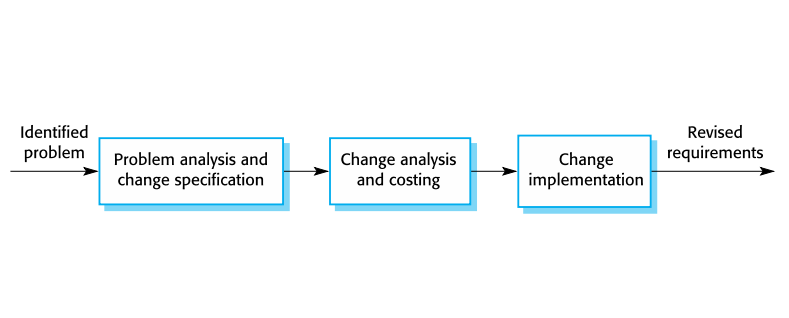Requirements Engineering
1/47
There's no tags or description
Looks like no tags are added yet.
Name | Mastery | Learn | Test | Matching | Spaced |
|---|
No study sessions yet.
48 Terms
Requirements engineering processes
The processes used for RE vary widely depending on the application domain, the people involved and the organisation developing the requirements.
RE
In practice, _____ is an iterative activity in which these processes are interleaved.
A spiral view of the requirements engineering process
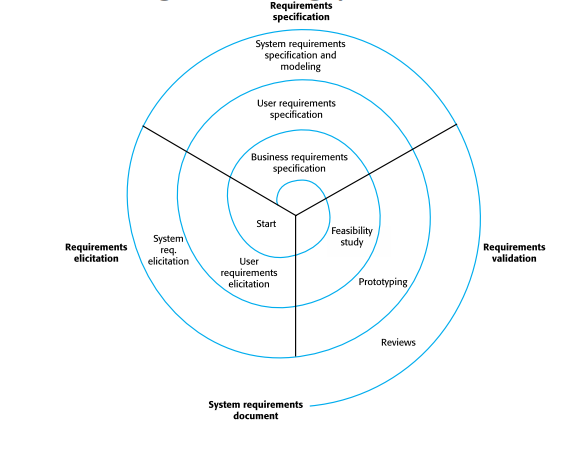
Requirements elicitation and analysis
• Sometimes called requirements elicitation or requirements discovery.
• Involves technical staff working with customers to find out about the application domain, the services that the system should provide and the system’s operational constraints.
• May involve end-users, managers, engineers involved in maintenance, domain experts, trade unions, etc. These are called stakeholders.
Problems of requirements analysis
• Stakeholders don’t know what they really want.
• Stakeholders express requirements in their own terms.
• Different stakeholders may have conflicting requirements.
• Organisational and political factors may influence the system requirements.
• The requirements change during the analysis process. New stakeholders may emerge and the business environment may change.
– Requirements discovery,
– Requirements classification and organization,
– Requirements prioritization and negotiation,
– Requirements specification.
• Software engineers work with a range of system stakeholders to find out about the application domain, the services that the system should provide, the required system performance, hardware constraints, other systems, etc.
• Stages include:
(4 kabuok)
The requirements elicitation and analysis process
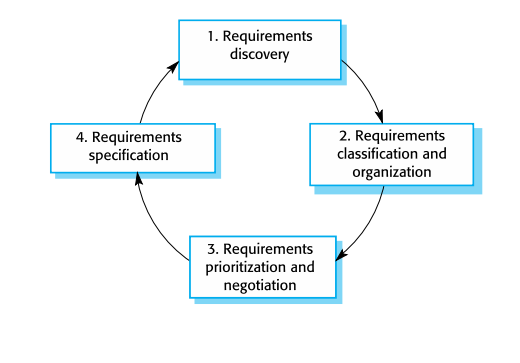
Requirements discovery
Interacting with stakeholders to discover their requirements. Domain requirements are also discovered at this stage.
Requirements classification and organisation
Groups related requirements and organises them into coherent clusters.
Prioritisation and negotiation
Prioritising requirements and resolving requirements conflicts.
Requirements specification
Requirements are documented and input into the next round of the spiral.
software requirements document
The ________ is an agreed statement of the system requirements. It should be organized so that both system customers and software developers can use it.
requirements engineering process
The __________ is an iterative process including requirements elicitation, specification and validation.
Requirements elicitation and analysis
___________ is an iterative process that can be represented as a spiral of activities – requirements discovery, requirements classification and organization, requirements negotiation and requirements documentation.
Requirements discovery
• The process of gathering information about the required and existing systems and distilling the user and system requirements from this information.
• Interaction is with system stakeholders from managers to external regulators.
• Systems normally have a range of stakeholders.
Interviewing
• Formal or informal interviews with stakeholders are part of most RE processes.
• Types of interview – Closed interviews based on pre-determined list of questions – Open interviews where various issues are explored with stakeholders.
• Effective interviewing
– Be open-minded, avoid pre-conceived ideas about the requirements and are willing to listen to stakeholders.
– Prompt the interviewee to get discussions going using a springboard question, a requirements proposal, or by working together on a prototype system.
Interviews in practice
• Normally a mix of closed and open-ended interviewing.
• Interviews are good for getting an overall understanding of what stakeholders do and how they might interact with the system.
• Interviews are not good for understanding domain requirements
– Requirements engineers cannot understand specific domain terminology;
– Some domain knowledge is so familiar that people find it hard to articulate or think that it isn’t worth articulating.
Scenarios
• _________ are real-life examples of how a system can be used.
• They should include
– A description of the starting situation;
– A description of the normal flow of events;
– A description of what can go wrong;
– Information about other concurrent activities;
– A description of the state when the scenario finishes.
Use cases
• _______ are a scenario based technique in the UML which identify the actors in an interaction and which describe the interaction itself.
• A set of ______ should describe all possible interactions with the system.
• High-level graphical model supplemented by more detailed tabular description
• Sequence diagrams may be used to add detail to use-cases by showing the sequence of event processing in the system.
Ethnography
• A social scientist spends a considerable time observing and analysing how people actually work.
• People do not have to explain or articulate their work.
• Social and organisational factors of importance may be observed.
• Ethnographic studies have shown that work is usually richer and more complex than suggested by simple system models.
Scope of ethnography
• Requirements that are derived from the way that people actually work rather than the way I which process definitions suggest that they ought to work.
• Requirements that are derived from cooperation and awareness of other people’s activities. – Awareness of what other people are doing leads to changes in the ways in which we do things.
• _________ is effective for understanding existing processes but cannot identify new features that should be added to a system.
Focused ethnography
• Developed in a project studying the air traffic control process
• Combines ethnography with prototyping
• Prototype development results in unanswered questions which focus the ethnographic analysis.
• The problem with ethnography is that it studies existing practices which may have some historical basis which is no longer relevant.
Ethnography and prototyping for requirements analysis
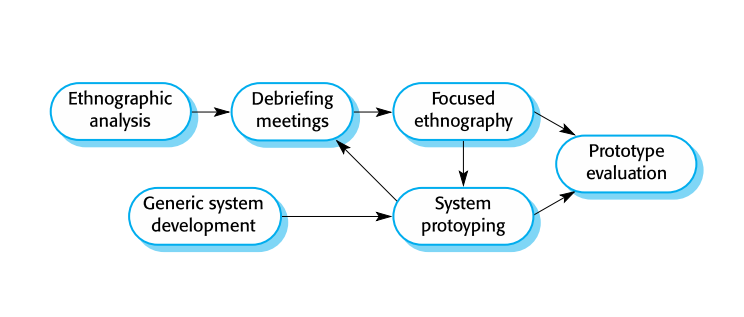
Requirements validation
• Concerned with demonstrating that the requirements define the system that the customer really wants.
• Requirements error costs are high so validation is very important
– Fixing a requirements error after delivery may cost up to 100 times the cost of fixing an implementation error.
Validity
Does the system provide the functions which best support the customer’s needs?
Consistency
Are there any requirements conflicts?
Completeness
Are all functions required by the customer included?
Realism
Can the requirements be implemented given available budget and technology
Verifiability
Can the requirements be checked?
Requirements validation techniques
Requirements reviews
Prototyping
Test-case generation
Requirements reviews
Systematic manual analysis of the requirements.
Prototyping
Using an executable model of the system to check requirements. Covered in Chapter 2.
Test-case generation
Developing tests for requirements to check testability.
Requirements reviews
• Regular reviews should be held while the requirements definition is being formulated.
• Both client and contractor staff should be involved in reviews.
• Reviews may be formal (with completed documents) or informal. Good communications between developers, customers and users can resolve problems at an early stage.
Review checks
Verifiability
Comprehensibility
Traceability
Adaptability
Requirements management
• ______________ is the process of managing changing requirements during the requirements engineering process and system development.
• New requirements emerge as a system is being developed and after it has gone into use.
• You need to keep track of individual requirements and maintain links between dependent requirements so that you can assess the impact of requirements changes. You need to establish a formal process for making change proposals and linking these to system requirements.
Changing requirements
• The business and technical environment of the system always changes after installation. – New hardware may be introduced, it may be necessary to interface the system with other systems, business priorities may change (with consequent changes in the system support required), and new legislation and regulations may be introduced that the system must necessarily abide by.
• The people who pay for a system and the users of that system are rarely the same people. – System customers impose requirements because of organizational and budgetary constraints. These may conflict with end-user requirements and, after delivery, new features may have to be added for user support if the system is to meet its goals.
Requirements evolution
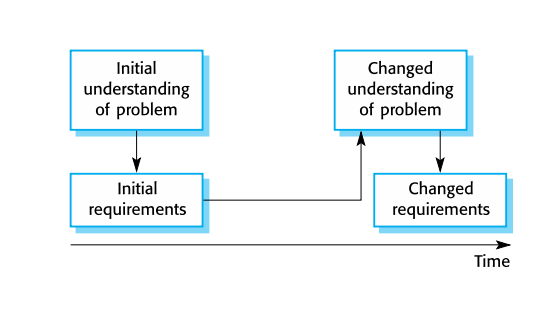
Requirements management planning
Establishes the level of requirements management detail that is required.
– Requirements identification Each requirement must be uniquely identified so that it can be cross-referenced with other requirements.
– A change management process This is the set of activities that assess the impact and cost of changes. I discuss this process in more detail in the following section.
– Traceability policies These policies define the relationships between each requirement and between the requirements and the system design that should be recorded.
– Tool support Tools that may be used range from specialist requirements management systems to spreadsheets and simple database systems.
Requirements management decisions:
Requirements identification
Each requirement must be uniquely identified so that it can be cross-referenced with other requirements.
A change management process
This is the set of activities that assess the impact and cost of changes. I discuss this process in more detail in the following section.
Traceability policies
These policies define the relationships between each requirement and between the requirements and the system design that should be recorded.
Tool support
Tools that may be used range from specialist requirements management systems to spreadsheets and simple database systems.
Problem analysis and change specification
During this stage, the problem or the change proposal is analyzed to check that it is valid. This analysis is fed back to the change requestor who may respond with a more specific requirements change proposal, or decide to withdraw the request.
Change analysis and costing
The effect of the proposed change is assessed using traceability information and general knowledge of the system requirements. Once this analysis is completed, a decision is made whether or not to proceed with the requirements change.
Change implementation
The requirements document and, where necessary, the system design and implementation, are modified. Ideally, the document should be organized so that changes can be easily implemented.
Requirements change management
